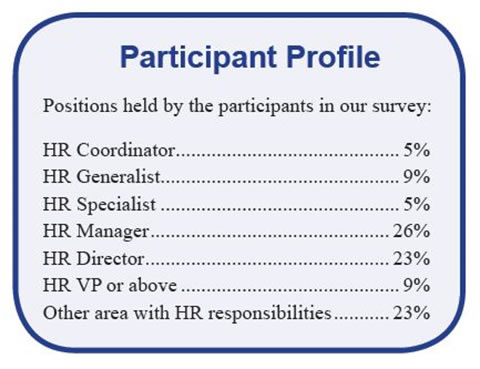In yesterday’s Advisor, we featured survey results (from 2032 participants) on standard and nonstandard perks. Today, data on telecommuting and dress codes, plus demographic data concerning survey participants.
 |
[For the beginning of the survey report, go here.]
Telecommuting
Formal telecommuting guidelines are in place and employees are required to sign a formal agreement for 23.8%. An allowance to cover employee expenses for setting up telecommuting at their home is provided by 33.1%, 40.3% reimburse telecommuting employees for monthly Internet connections, and 54.2% reimburse for telephone expenses.
Offering telecommuting to employees brings:
|
Result |
Percent of employers that offer telecommuting |
|
Improved employee morale |
42.1% |
|
Improved recruiting and retention |
43.9% |
|
Reduced absenteeism |
18.6% |
|
Savings on office space and other resources |
22.2% |
|
Higher employee productivity |
43.9% |
When asked how satisfied with their telecommuting arrangements they are, 27.5% indicated they are very satisfied, 31% are somewhat satisfied, 32.3% are neutral, 7.4% are somewhat dissatisfied, and 1.9% are very dissatisfied.
Dress Codes
|
Code |
Percent of respondents indicating |
|
|
Relaxed and casual |
53.8% |
|
|
Very relaxed |
10% |
|
|
Traditional business attire is required |
36% |
|
|
Strictly suits |
Less than 1% |
|
|
Dress code is relaxed during the summer months for all |
30.4% |
|
|
Dress code is relaxed during the summer months only for employees with no customer contact |
13.6% |
|
Dress-down days are offered by 72.7%, but only for employees with no customer contact for 15.6%. Friday casual is the norm for 74.8% but only on or near holidays for 14.8%. Dress-down attire is a reward for performance or fundraising for 10.5%.
HR budget cuts? Let us help. HR.BLR.com is your one-stop solution for all your HR compliance and training needs. Take a no-cost, no-obligation trial and get a complimentary copy of our special report Critical HR Recordkeeping—From Hiring to Termination. It’s yours—no matter what you decide.
Survey Participants
Organizations with up to 250 employees account for 61.6% of our survey participants, and 22.6% have 251 to 1,000 employees. Another 15.7% work in organizations with more than 1,000 employees.
Of the participants responding to our survey, 45.9% have a workforce with 25% or fewer exempt employees. Another 22.6% have a workforce that is 26% to 50% exempt and 23.2% have a workforce with more than 50% exempt employees. Unions represent nonexempt employees at 21% of our survey participant employers and exempt employees at 12.6%.
Privately held for-profit organizations are represented by 59.6% of survey participants, and privately held nonprofits account for 22.1%. The public sector makes up 18.2%. Industries include manufacturing (17.7%); health care and social assistance (14.3%); finance and insurance (10%); and professional, technical, and scientific services (9.6%). Educational services represent 6% of our survey participants, and retail trade accounts for 3.3%.

Our 2,032 survey participants include those in staff positions (15.5%), supervisors (5.2%), manager level (57%), and VP or above (22.3%).
Thanks to all who participated!
From perks to telecommuting to dress codes, and from hiring to firing, HR never sleeps. You need a go-to resource, and our editors recommend the “everything-HR-in-one website, HR.BLR.com®. As an example of what you will find, here are some policy recommendations concerning e-mail, excerpted from a sample policy on the website:
- Privacy. The director of information services can override any individual password and thus has access to all e-mail messages in order to ensure compliance with company policy. This means that employees do not have an expectation of privacy in their company e-mail or any other information stored or accessed on company computers.
- E-mail review. All e-mail is subject to review by management. Your use of the e-mail system grants consent to the review of any of the messages to or from you in the system in printed form or in any other medium.
- Solicitation. In line with our general policy, e-mail must not be used to solicit for outside business ventures, personal parties, social meetings, charities, membership in any organization, political causes, religious causes, or other matters not connected to the company’s business.
Find out what the buzz is all about. Take a no-cost look at HR.BLR.com, solve your top problem, and get a complimentary gift.
We should point out that this is just one of hundreds of sample policies on the site. (You’ll also find analyses of all the HR-related laws and the current critical issues, plus downloadable job descriptions, and complete training materials for hundreds of HR topics.)
You can examine the entire HR.BLR.com® program free of any cost or commitment. It’s quite remarkable—30 years of accumulated HR knowledge, tools, and skills gathered in one place and accessible at the click of a mouse.
What’s more, we’ll supply a free downloadable copy of our special report, Critical HR Recordkeeping—From Hiring to Termination, just for looking at HR.BLR.com®. If you’d like to try it at absolutely no cost or obligation to continue (and get the special report, no matter what you decide), go here.
